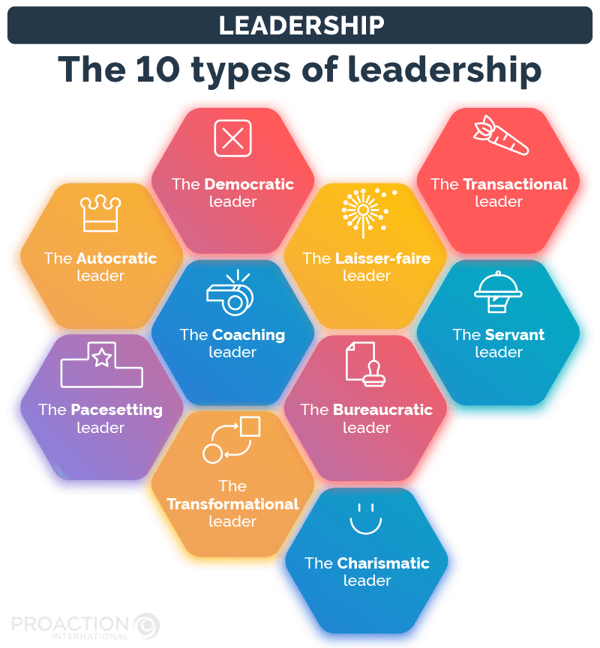The 10 major types of leader
Over the years, experts such as Kurt Lewin, James MacGregor Burns, Robert K. Greenleaf, Max Weber, Daniel Goleman, and many others have examined the question of leadership.
Today, 10 significant types of leadership styles can be observed in organizations around the world:

1. The autocratic leader
The autocratic leadership style (or authoritarian leadership) stands out for its authority and total control. This leader makes most decisions independently and expects employees to follow orders without interfering too much.
While such authoritarian leaders can be influential in crises, particularly when decisions must be made quickly, they can also undermine employees' morale and limit creativity. Autocratic leaders are better suited to well-defined tasks and clear directives.
Benefits
- Enables rapid decision-making in crises.
- Provides structure through clear directives.
- Works for well-defined tasks.
Drawbacks
- Stifles employee creativity and initiative.
- Creates a feeling of underestimation among employees.
- Can lead to low morale and employee resistance.
2. The democratic leader
Democratic leaders seek the opinions of their team members. They value the development of skills and the contribution of employees, and involve them in decision-making. They encourage communication, initiative-taking, collaboration, and inclusiveness.
Democratic leaders create a working environment in which each individual feels heard and respected. Such leaders demonstrate a strong willingness to work hand-in-hand with employees to achieve common goals.
The democratic leadership style (also known as participative or collaborative leadership style) creates a sense of belonging among employees, which leads to higher motivation, engagement, and job satisfaction.
Benefits
- Enhances employee motivation and engagement.
- Creates a positive work environment.
- Boosts productivity, creativity and innovation.
Drawbacks
- Slows down the decision-making process.
- Can create conflict due to differing opinions.
- May be less effective in urgent situations.
3. The laissez-faire leader
Laissez-faire leadership (or delegative leadership) adopts a peculiar stance. As the name suggests, they prefer to intervene as little as possible, leaving their team members free to make decisions and solve problems independently without giving them too much guidance.
Laissez-faire leaders work well with highly motivated, experienced employees who thrive in a more autonomous environment. However, it can lead to a lack of direction and accountability if not correctly managed.
Benefits
- Reinforces competent, motivated teams.
- Encourages creativity and autonomy.
- Encourages task ownership.
Drawbacks
- May need more guidance.
- Negatively impacts productivity if the group needs more direction.
- May only be suitable for more experienced employees.
4. The transactional leader
Transactional leaders set clear expectations for their employees. They then use rewards and punishments based on their performance.
Transactional leadership is effective for short-term objectives in structured environments but can harm long-term development and is unsuitable for creative, autonomous teams.
Benefits
- Reinforces employee accountability through clear expectations.
- Offers rewards which improves performance.
- Is suitable for routine tasks.
Drawbacks
- Focuses on short-term objectives.
- May discourage creativity and risk-taking.
- Can lead to transactional relationships.
5. The servant leader
Servant leaders put the needs of their team members first. Their primary objective is to support, empower, and give them the means to be fully autonomous to facilitate their professional and personal development.
The servant leadership style values trust, loyalty, and teamwork. It leads to increased job satisfaction and productivity.
Benefits
- Reinforces employee trust and loyalty.
- Empowers and develops relationships between team members.
- Creates a positive work culture.
Drawbacks
- May take time to address individual needs.
- Can lead to manager burnout.
- May give an impression of a lack of control.
6. The bureaucratic leader
Bureaucratic leaders strictly follow rules, policies, and procedures to maintain stability and consistency within the company.
The bureaucratic leadership style is best suited to organizations that value predictability and compliance, such as government agencies or large organizations with complex hierarchies. On the other hand, focusing so much on compliance with standards and procedures can hinder creativity and adaptability.
Benefits
- Provides consistency and stability.
- Ensures compliance with rules and procedures.
- Effective in highly regulated sectors.
Drawbacks
- Stifles creativity, innovation, and flexibility.
- May lead to a lack of initiative.
7. The coaching leader
The coaching leadership style focuses on the individual and collective development of their employees, adopting an approach centered on growth and continuous learning.
Coaching leaders can inspire, motivate, and guide employees toward achieving their goals. They don't just give directions but actively encourage reflection, empowerment, and decision-making within their teams.
They foster an environment where workers are encouraged to explore their skills, learn from their mistakes, and grow professionally. Overall, the coaching leadership approach focuses on team progression, promoting autonomy and individual growth.
Benefits
- Fosters a strong sense of commitment within the team.
- Stimulates creativity and innovation.
- Reinforces talent engagement within the organization.
Drawbacks
- Can be a challenge for some managers in terms of communication, active listening, and constructive feedback.
- May take time to see results.
- May not be suitable during emergencies.
8. The pacesetting leader
Pacesetting leadership is characterized by the leader's ability to inspire and influence others by being a role model, embodying the values and behaviors expected within the organization. What sets them apart is their exemplarity. They represent the company's standards and set an example through their conduct and commitment.
These leaders are often models of integrity, ethics, and dedication, earning the respect and admiration of their colleagues.
Benefits
- Creates a strong, consistent corporate culture.
- Fosters trust and loyalty within the team.
- Is effective in environments where safety, regularity, and compliance are essential.
Drawbacks
- Can be perceived as rigid or inflexible.
- Can be personally draining as high standards must be maintained at all times.
9. The transformational leader
Transformational leaders (or visionary leadership) inspire and motivate employees with a compelling vision of the future. They encourage innovation, continuous learning, and personal growth. They lead by example, inspiring others to go the extra mile to achieve their goals.
Transformational leadership is highly effective in stimulating innovation and creativity and in situations of change requiring a certain degree of flexibility.
Benefits
- Inspires innovation and growth.
- Motivates employees to exceed expectations.
- Fosters strong team bonds.
Drawbacks
- Can lead to high dependency on the leader.
- Requires constant communication.
- Can be exhausting for the leader.
10. The charismatic leader
Charismatic leaders shine through their personality and charm, inspiring and influencing those around them. Exceptionally gifted in communication and at ease in interpersonal relations, they excel in the art of uniting different teams around a goal, a shared future.
While this leadership style can generate enthusiasm and commitment, it can also prove risky if the leader's vision doesn't work.
Benefits
- Inspires enthusiasm and commitment.
- Influences and attracts employees towards a compelling vision.
- Energizes teams during challenges.
Drawbacks
- Is highly dependent on the personality of the leader.
- Leads through a vision that is sometimes driven by emotion (rather than logic).
- Can be challenging when leadership changes.
What's the difference between transformational and charismatic leadership?
Although transformational (or visionary) leadership is sometimes confused with charismatic leadership, the two concepts differ in their focus and principles.
Transformational leaders are visionary leaders who impact people and the organization in the long-term, fostering sustainable growth and change. Their collective and inspiring vision helps to change individuals and shape the organization.
Charismatic leadership can have a more immediate impact, often linked to presence and persuasiveness. These leaders' charm, their unique appeal, makes people want to follow them.
What about frontline managers in the manufacturing sector?
A frontline manager's profile differs slightly from a company executive's. In manufacturing, the frontline manager plays a significant role acting, on one hand, directly in the field, close to the workers, and on the other hand, as an intermediary between employees and the senior management.
Frontline managers have 4 primary leadership styles: conqueror, technical, peacemaker, and managerial. The managerial leadership style is the ideal of the manager 5.0, a model that can be developed with the help of an expert coach.
How do you know which leadership style to use in your company?
Your leadership style heavily impacts your teamwork and, therefore, the organization's performance. Let’s see what are the most effective leadership styles depending on the situation.
- Analyze the organizational culture: Understanding the values, norms, and expectations that define the culture of the organization is essential. For example, some may favor collaborative decision-making (democratic style), while others may require adherence to procedures (bureaucratic style).
- Assess tasks and objectives: Consider the complexity, urgency, and importance of tasks. In fast-paced environments, a more flexible style is often required (transformational style), while for routine tasks, a more structured approach may be more appropriate (transactional style).
- Evaluate employee's development levels: Assess the know-how and commitment of each team member. Are they new and inexperienced (autocratic style), or more experienced and motivated (laissez-faire style)?
- Consider the situation: Consider the current situation or challenge. Is it a crisis that requires quick decisions (autocratic style) in order to be resolved, or does it require innovation and creativity (transformational style)?
To find the right leadership approach for your organization, we recommend gathering feedback from your employees to understand their preferences and expectations, and monitoring performance and engagement to adjust your style as necessary.
The importance of adapting leadership styles
Being able to modulate your leadership style is an important skill and offers multiple benefits.

Increased employee performance
Your employees have different levels of experience, motivation, and development. Adapting leadership styles ensures that each individual receives the appropriate support and guidance to excel.
Strengthened engagement
When your employees feel that you understand and respond to their needs and that they are dealing with someone flexible and human, they are more likely to be engaged and motivated to bring their A game.
Improved communication
Adapting your leadership style improves communication by delivering the right message to your employees. This means fewer misunderstandings and greater clarity.
Sense of trust and respect from teams
Showing that you care about your employees' well-being and development is an excellent way of gaining their trust and respect.
Development of internal skills
By providing guidance and support, you help your teams develop new skills, enabling them to grow within the organization. The company can, in turn, benefit from a highly skilled workforce.
Creation of a positive work environment
Adapting your leadership style helps create a more positive and harmonious atmosphere with fewer conflicts.
Rather than using a single type of leadership, influential leaders know how to adapt their leadership style to any situation and employee dynamic. There is no one-size-fits-all approach.
The best leadership style depends on factors such as the team's composition, the nature of the task, the type of organization, the culture, and the desired results.
A versatile leader can draw on these styles to create a balanced approach that maximizes performance and the well-being of all team members, employees, managers and executives alike.
Use the know-how of a coach to optimize your leadership
Being the best executive with all the right characteristics is possible. But first, you must learn how to adapt your leadership style based on the needs of your organization. That's where coaching comes in, as it can help you build the right reflexes for flexible, effective management.
Coaching sessions enable you to identify your strengths, weaknesses, and management behaviors. This heightened self-awareness is fundamental to seeing whether your leadership style matches the organization's goals and needs and your teams' unique dynamics.
The coach also helps you assess situations and determine when a specific leadership style is more relevant. This way, you become more agile and you can adapt your approach to the context.
An experienced coach gives leaders advice, tips, techniques (like Toyota Kata), and practice opportunities. They provide an outside, expert point of view and constructive feedback to further your own development. They also foster discussion to assess your progress, challenges, and the adjustments you need to make.
By offering personalized support and a structured framework, coaching enables you to develop your leadership style in harmony with the organization's objectives, thereby improving the performance of your teams.
It provides the tools to become agile, effective leaders capable of navigating today’s dynamic business landscape.
Juggling different types of leadership: The key to effective management
There is not a single recipe for effective leadership. These 10 types of leadership call for flexibility and provide an overview of your management options, with the objective of inspiring, motivating, and guiding your teams. They should be used in conjunction with one another, depending on the situation.
By understanding the nuances of each style and when to apply them, you can foster collaboration, innovation, and growth within your company, as well as gender diversity, inclusion, and equality.










